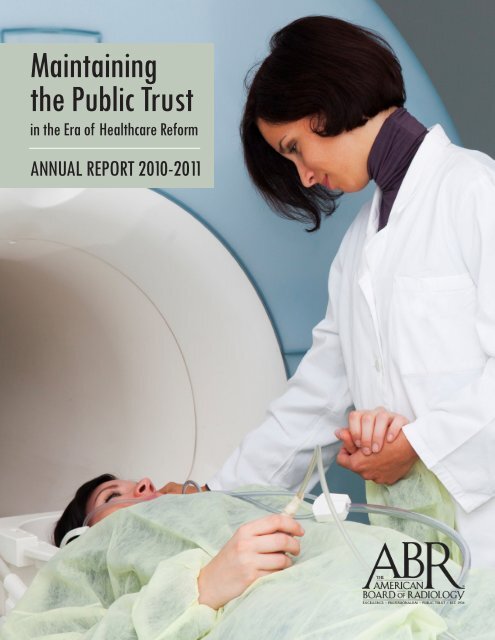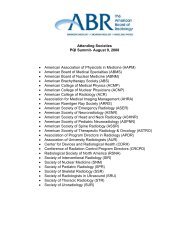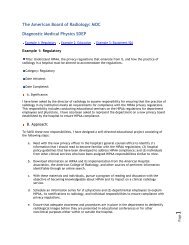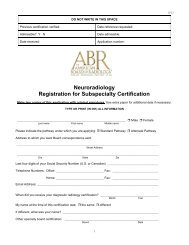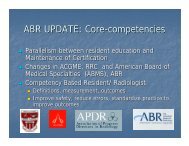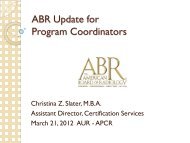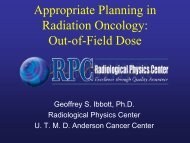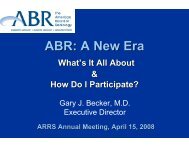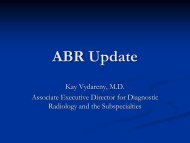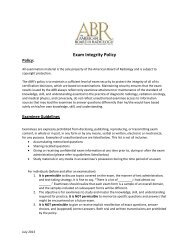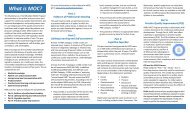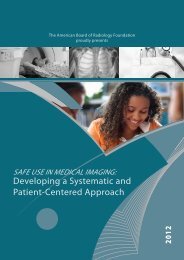Maintaining the Public Trust - The American Board of Radiology
Maintaining the Public Trust - The American Board of Radiology
Maintaining the Public Trust - The American Board of Radiology
You also want an ePaper? Increase the reach of your titles
YUMPU automatically turns print PDFs into web optimized ePapers that Google loves.
Throughout <strong>the</strong> year, consideringall oral and computer-based examsin all locations, <strong>the</strong> ABR administers44 different types <strong>of</strong> exams.Ano<strong>the</strong>r key effort under way in training and initialcertification is <strong>the</strong> Milestones Project, a joint effort<strong>of</strong> <strong>the</strong> Accreditation Council for Graduate MedicalEducation (ACGME) and each <strong>of</strong> <strong>the</strong> specialty boards.<strong>The</strong> goal is to determine a list <strong>of</strong> key milestones in trainingthat each resident must achieve at specified timepoints to be considered ready for independent practice.<strong>The</strong> Diagnostic <strong>Radiology</strong> Milestones Working Group,chaired by Kay Vydareny, MD, ABR associate executivedirector for diagnostic radiology and past chair <strong>of</strong><strong>the</strong> Diagnostic <strong>Radiology</strong> Residency Review Committee,had two very productive meetings in March andSeptember <strong>of</strong> 2011. <strong>The</strong> committee has written draftmilestones for each <strong>of</strong> <strong>the</strong> six ACGME competencies(medical knowledge, patient care and technical skills,pr<strong>of</strong>essionalism, interpersonal and communicationskills, systems-based practice, and practice-basedlearning and improvement) and plans to present <strong>the</strong>mfor feedback at <strong>the</strong> Association <strong>of</strong> Program Directors in<strong>Radiology</strong> (APDR) meeting in March 2012.Also in March 2011, <strong>the</strong> <strong>Board</strong> introduced a tightening<strong>of</strong> its exam security policies and communicated extensivelywith candidates, training program directors, andchairs to begin a culture change in which systematicsharing <strong>of</strong> exam content in <strong>the</strong> form <strong>of</strong> “recalls” withinand across programs will be discouraged. This effort,designed to conserve ABR resources and protect <strong>the</strong>integrity <strong>of</strong> <strong>the</strong> examinations upon which <strong>the</strong> <strong>Board</strong>bases <strong>the</strong> assurances it makes to <strong>the</strong> public about itsdiplomates, emphasizes <strong>the</strong> importance <strong>of</strong> <strong>the</strong> corecompetency <strong>of</strong> pr<strong>of</strong>essionalism.As I think about <strong>the</strong> explosion in work due to <strong>the</strong> needto build <strong>the</strong> future exams, even as we prepare anddeliver <strong>the</strong> current ones and adapt to <strong>the</strong> many changesoccurring in MOC, I am impressed that a staggeringlycomplex enterprise is thriving and moving ahead, owingto our talented, hard-working staff in <strong>Board</strong> Affairs,Certification Services (Candidate and Diplomate Services,Exam Delivery, and Exam Development), Communicationsand Editorial Serivices, Digital Imaging,Finance, Information Technology, and Psychometricsand Evaluation. More about <strong>the</strong>se areas, including initialcertification and MOC, can be found in o<strong>the</strong>r sections <strong>of</strong>this report.Aligning MOC with Practice LifeMOC poses a “chicken-or-egg” challenge. For MOCto be recognized as a key contributor to improvedhealthcare quality, safety, and affordability, boardsmust demonstrate that MOC participants deliver bettercare and outcomes than do nonparticipants, and that<strong>the</strong>y do so at a lower cost. Yet many diplomates wantto see this pro<strong>of</strong> as a precondition to participation. <strong>The</strong>obvious dilemma is that participation is required inorder to produce <strong>the</strong> data that will establish <strong>the</strong> value<strong>of</strong> MOC. Never<strong>the</strong>less, considering <strong>the</strong> best interests <strong>of</strong><strong>the</strong> public, it defies logic for detractors to argue againsta program <strong>of</strong> lifelong learning and continuous pr<strong>of</strong>essionaldevelopment, and in favor <strong>of</strong> <strong>the</strong> pre-MOC statusquo, with state medical licensure as <strong>the</strong> only ongoingrequirement.Throughout <strong>the</strong> debate and discussion about MOC,one thing has become very clear to <strong>the</strong> ABR: MOCcan succeed in delivering improved healthcare, basedon <strong>the</strong> standards we set, only if those standards areimplemented by our practicing diplomates. <strong>The</strong>refore,in addition to protecting <strong>the</strong> public, MOC must deliversufficient value to <strong>the</strong> diplomates <strong>the</strong>mselves.With this in mind, <strong>the</strong> ABR and ABMS have been workingto align MOC requirements with all o<strong>the</strong>r aspects <strong>of</strong>practice life, including o<strong>the</strong>r requirements, incentives,medical licensure, and routine workflow. Key examples(not all-inclusive) are listed below:• <strong>The</strong> Physician Quality Reporting System (PQRS) MOCProgram Incentive• Development <strong>of</strong> practice performance measures forPQRS reporting and Part IV <strong>of</strong> MOC• Alignment with Maintenance <strong>of</strong> Licensure (MOL)• Focused practice recognition within MOC• Group participation in MOC for large community andacademic practices• MOC Part IV portfolio sponsor recognition/approvalFur<strong>the</strong>r details on <strong>the</strong>se initiatives can be found in <strong>the</strong>MOC section <strong>of</strong> this report (see Page 12).5
Executive Director’s ReportGoing GreenIn addition to serving our diplomates while protecting<strong>the</strong> public, <strong>the</strong> ABR is committed to protecting our environmentby “going green.” A few <strong>of</strong> <strong>the</strong> changes visiblearound <strong>the</strong> <strong>of</strong>fice include a dishwasher, plates, glasses,and cutlery to decrease <strong>the</strong> use <strong>of</strong> plastic products formeals; recycling containers available in numerous locations;water coolers to eliminate <strong>the</strong> use <strong>of</strong> plastic waterbottles; and a timer for <strong>the</strong> <strong>of</strong>fice’s <strong>the</strong>rmostat controlsystem to minimize <strong>the</strong> use <strong>of</strong> power for air conditioningand heating during nonworking hours. Finally, onJune 25, 2011, <strong>the</strong> 75.9-kilowatt system <strong>of</strong> 330 photovoltaiccells (solar panels) on <strong>the</strong> ABR’s ro<strong>of</strong> beganproviding about 20 percent <strong>of</strong> <strong>the</strong> <strong>of</strong>fice’s electric powerrequirements (see Page 15).A Word on FinancesIn last year’s Annual Report (click here to view), my articleon “ABR Financial Transparency” concentrated on where<strong>the</strong> dollars go at <strong>the</strong> ABR. In addition, I explained thattrustees had designated more than 90 percent <strong>of</strong> <strong>the</strong>ABR’s reserves for several specific purposes, including:• one year <strong>of</strong> operating expenses for emergency use;• a five-year plan for capital expenditures;• construction <strong>of</strong> exam centers to deliver <strong>the</strong> ABR’simage-rich examinations;• <strong>the</strong> dual exam development process we’re now supportingas an expanded number <strong>of</strong> committees createnot only <strong>the</strong> current qualifying, oral, and MOC exami-BuildingMOCBuilding2%ICnations for all three disciplines, but also <strong>the</strong> new Coreand Certifying examinations for diagnostic radiology;• five years <strong>of</strong> information technology initiatives;• expert consultation; and• a small amount for <strong>the</strong> ABR Foundation.This year, reserve funds are in fact being used inaccordance with several <strong>of</strong> <strong>the</strong>se designated areas andare proving essential to <strong>the</strong> execution <strong>of</strong> ABR businessduring this three- to four-year transition to <strong>the</strong> Coreand Certifying examinations. Many <strong>of</strong> <strong>the</strong> expenses areei<strong>the</strong>r doubled (committees) or directly related to examdelivery, e.g., building out exam centers in Chicago andTucson and completing <strong>the</strong> development <strong>of</strong> our itembankingsystem, known as ATOMS (ABR Testing Organizationand Management System). <strong>The</strong> pie charts belowprovide an overview <strong>of</strong> ABR revenues and expenses for<strong>the</strong> 2010-11 fiscal year ending March 31, 2011.SummaryTransformational change and exponential increases inwork volume and complexity are under way at <strong>the</strong> ABR.<strong>The</strong> <strong>Board</strong> <strong>of</strong> <strong>Trust</strong>ees, ABR executive leadership, andmanagement are working toge<strong>the</strong>r to keep costs down,minimize <strong>the</strong> impact <strong>of</strong> growth on candidate and diplomatefees, and secure <strong>the</strong> rightful place <strong>of</strong> ABR-certifieddiagnostic radiologists, radiation oncologists, and medicalphysicists in <strong>the</strong> future <strong>of</strong> <strong>American</strong> healthcare.Gary J. Becker, MDExecutive Director2010-2011 ABR Financial StatisticsInitialCertification55%BOT Meetings 4%ComputerizedExams 4%ABMS3%Processing Fees 3%Depreciation 3%Building 4%Meetings5%OutsideLabor 3%Personnel53%Outside LABMSProcessinBuildingMaintenance<strong>of</strong> Certification42%Office7%Oral Exam13%DepreciatBOT meet6RevenueExpensesComputeMeetingsOffice
New <strong>Trust</strong>ees 2011<strong>The</strong> ABR welcomes <strong>the</strong> following new trustees, whoseterms <strong>of</strong> service began on July 1, 2011. ABR trusteesparticipate in leadership and decision making to carryout <strong>the</strong> ABR’s mission and set standards for <strong>Board</strong>certification in initial certification and Maintenance <strong>of</strong>Certification.Vincent P. Ma<strong>the</strong>ws, MD,serves as president and chiefexecutive <strong>of</strong>ficer <strong>of</strong> Northwest<strong>Radiology</strong> Network, Indianapolis,Indiana. He graduated fromIndiana University School<strong>of</strong> Medicine with highestdistinction. He completed aresidency in diagnostic radiologyat Indiana University MedicalCenter Hospitals and a fellowship in neuroradiology atJohns Hopkins Hospital. He has received four MagnaCum Laude Awards and eight Cum Laude Awardsfor scientific exhibits from <strong>the</strong> <strong>American</strong> Society <strong>of</strong>Neuroradiology and <strong>the</strong> Radiological Society <strong>of</strong> NorthAmerica. He also received a Gold Medal for scientificexhibits from <strong>the</strong> <strong>American</strong> Roentgen Ray Society.Dr. Ma<strong>the</strong>ws’ special interests include stroke,epilepsy, and physiological neuroimaging, includingfunctional MR imaging and MR spectroscopy. Heis former chief <strong>of</strong> neuroradiology and director <strong>of</strong><strong>the</strong> Neuroradiology Fellowship Program at IndianaUniversity School <strong>of</strong> Medicine, where he still servesas pr<strong>of</strong>essor <strong>of</strong> neuroradiology. From 1995 to 2003,he was a consultant and an ad hoc reviewer for <strong>the</strong>National Institutes <strong>of</strong> Health. He is certified by <strong>the</strong> ABRin diagnostic radiology and also holds subspecialtycertification in neuroradiology.Brent J. Wagner, MD, has beena member <strong>of</strong> West Reading<strong>Radiology</strong> Associates since1998 and is currently director <strong>of</strong><strong>the</strong> Department <strong>of</strong> <strong>Radiology</strong>and president <strong>of</strong> <strong>the</strong> medicalstaff at <strong>The</strong> Reading Hospitaland Medical Center, Reading,Pennsylvania. He also serveson West Reading <strong>Radiology</strong>Associates’ <strong>Board</strong> <strong>of</strong> Directors and is a former staffmember and current visiting lecturer for <strong>the</strong> <strong>American</strong>Institute for Radiologic Pathology.Dr. Wagner completed his internship at RoanokeMemorial Hospital, Roanoke, Virginia, and <strong>the</strong>nserved in <strong>the</strong> U.S. Air Force for 10 years, completinghis residency at Wilford Hall USAF Medical Center,Lackland Air Force Base, Texas. He is author or coauthor<strong>of</strong> nearly 50 publications, including Davidson’s<strong>Radiology</strong> <strong>of</strong> <strong>the</strong> Kidney and Genitourinary Tract, andhe lectures regularly on many genitourinary topics.He also is a part-time member <strong>of</strong> <strong>the</strong> teaching facultyat Hershey Medical Center, Penn State University,University Park, Pennsylvania. Dr. Wagner’s specialinterests and expertise include all areas <strong>of</strong> MRI andultrasound. He is certified by <strong>the</strong> ABR in diagnosticradiology and is also a diplomate <strong>of</strong> <strong>the</strong> National <strong>Board</strong><strong>of</strong> Medical Examiners.Lynn D. Wilson, MD, MPH,is vice chair and pr<strong>of</strong>essor <strong>of</strong><strong>the</strong>rapeutic radiology andpr<strong>of</strong>essor <strong>of</strong> dermatology for YaleUniversity School <strong>of</strong> Medicine. Hejoined <strong>the</strong> faculty in 1994 and isa member <strong>of</strong> Yale Cancer Centerand <strong>the</strong> Yale Cancer CenterThoracic Oncology Program.In addition, he serves as clinicaldirector and residency training program director for <strong>the</strong>Department <strong>of</strong> <strong>The</strong>rapeutic <strong>Radiology</strong>.Dr. Wilson received <strong>the</strong> Francis Gilman Blake Award,designated by <strong>the</strong> senior class and presented to a YaleSchool <strong>of</strong> Medicine faculty member for exceptionalteaching <strong>of</strong> <strong>the</strong> medical sciences. Yale Medical Groupalso honored him with <strong>the</strong> first David J. Leffell Prizefor Clinical Excellence, bestowed on a faculty memberwho best exemplifies clinical expertise, a commitmentto teaching, and <strong>the</strong> highest standards <strong>of</strong> care andcompassion for patients.Dr. Wilson earned a medical degree from GeorgeWashington University and a master’s degree in publichealth from Yale University School <strong>of</strong> Medicine. Healso completed a residency and internship at Yale-New Haven Hospital and was chief resident in <strong>the</strong>Department <strong>of</strong> <strong>The</strong>rapeutic <strong>Radiology</strong>. Dr. Wilson’sclinical research interests include cutaneous lymphoma,lung cancer, benign and malignant tumors <strong>of</strong> <strong>the</strong> skin,breast cancer, and total skin electron beam <strong>the</strong>rapy. Heis certified by <strong>the</strong> ABR in radiation oncology.7
Retiring <strong>Trust</strong>ees 2011<strong>The</strong> ABR thanks <strong>the</strong> following trustees, whose termsended in June 2011. We greatly appreciate <strong>the</strong>ir manyyears <strong>of</strong> faithful and dedicated volunteer service.N. Reed Dunnick, MD, served asan ABR trustee for nine years andwas president <strong>of</strong> <strong>the</strong> <strong>Board</strong> from2008 to 2010. During his tenure,he served on 13 <strong>Board</strong> committeesand subcommittees, includingAudit, Budget & Finance,Maintenance <strong>of</strong> Certification,Investment, and Policy. He wasan Executive Committee memberfor five years. He is <strong>the</strong> FredJenner Hodges pr<strong>of</strong>essor and chair <strong>of</strong> <strong>the</strong> Department<strong>of</strong> <strong>Radiology</strong> at <strong>the</strong> University <strong>of</strong> Michigan. Dr. Dunnickis also <strong>Board</strong> Liaison for Science for <strong>the</strong> RadiologicalSociety <strong>of</strong> North America.Beth A. Erickson, MD, was anABR trustee for eight years, duringwhich she served on 13 <strong>Board</strong>committees and subcommittees,including Pr<strong>of</strong>essionalism Licensure,Investment, and <strong>the</strong> ExecutiveCommittee. In 2010-11, shewas chair <strong>of</strong> <strong>the</strong> Policy, RadiationOncology (RO) Breakout, and ROFocused Practice committees.Dr. Erickson continues to volunteer her assistance indeveloping <strong>the</strong> ABR’s new demonstration pilot programon focused practice recognition in brachy<strong>the</strong>rapy. She ispr<strong>of</strong>essor <strong>of</strong> radiation oncology at <strong>the</strong> Medical College<strong>of</strong> Wisconsin, Milwaukee.Glenn S. Forbes, MD, was anABR trustee for eight years,during which he served on nine<strong>Board</strong> committees and subcommittees,including Bylaws,Subspecialty, Diagnostic <strong>Radiology</strong>Breakout, and <strong>the</strong> ExecutiveCommittee. He was chair <strong>of</strong> <strong>the</strong>Audit Committee in 2010-11. Dr.Forbes began serving as chair <strong>of</strong><strong>the</strong> ABR Foundation in July 2011. He is currently a pr<strong>of</strong>essor<strong>of</strong> radiology at Mayo Medical School and medicaldirector for Mayo Clinic Imaging Solutions, <strong>the</strong> businessunit within Mayo Clinic’s diversified activities.8ABR Staff ReorganizationIn June 2010, a staff reorganization began at <strong>the</strong><strong>American</strong> <strong>Board</strong> <strong>of</strong> <strong>Radiology</strong>’s Tucson <strong>of</strong>fice. <strong>The</strong>plan was based on a variety <strong>of</strong> needs: improvingprocesses, gaining efficiencies, eliminating “singlepoints <strong>of</strong> failure,” enhancing communications andteamwork, and increasing transparency. <strong>The</strong> reorganizationprimarily impacted three areas: InitialCertification (IC) Services, Maintenance <strong>of</strong> Certification(MOC) Services, and Administration/VolunteerServices.IC and MOC Services were combined into two divisions:Certification Services and Standards. <strong>The</strong>divisions not only cut across IC and MOC, but alsoacross diagnostic radiology, radiation oncology, andmedical physics.Certification Services, directed by David Laszakovits,MBA, has three subdivisions: 1) Exam Development,Joe Kamell, MBA, assistant director; 2) ExamDelivery, Lydia Warg, MS, assistant director; and 3)Candidate and Diplomate Services, Christina Slater,MBA, assistant director.Three areas <strong>of</strong> core competency are <strong>the</strong> basis for <strong>the</strong>Standards Division: 1) Psychometrics, directed byAnthony Gerdeman, PhD (June Yang, PhD, assistantdirector); (2) Digital Imaging, directed by MichaelEvan<strong>of</strong>f, PhD (Aaron Gudenkauf, assistant director);and (3) Communications and Editorial Services,directed by Donna Breckenridge, MA.<strong>The</strong> Administration Division was reorganized as a<strong>Board</strong> Affairs Division to streng<strong>the</strong>n <strong>the</strong> focus ontrustee and volunteer services. Jennifer Hutson,MBA, directs this area and is <strong>the</strong> point person fortrustee requests and <strong>the</strong> need for general information.<strong>The</strong>re is close coordination with <strong>the</strong> ExamDevelopment subdivision to ensure seamless management<strong>of</strong> volunteer services.<strong>The</strong> remaining two ABR divisions are InformationTechnology (IT), directed by John Adams, and FinancialServices, directed by Vicki Franz, CPA. Assistantdirectors for IT include Chris Mazzarella, MBA, testingservices, and Keith Scollick, s<strong>of</strong>tware/data development.Gail Ugstad, MBA, MSA, serves as assistantdirector for Financial Services.
Initial Certification ReportOnline Examination ResultsSince <strong>the</strong> 2010 oral exam administration, <strong>the</strong> ABRhas published results <strong>of</strong> its exams online for candidates,training program directors, and program chairs.<strong>The</strong> ABR is committed to providing accurate results ina timely manner, and a team effort among staff andtrustees has resulted in a refined process that increases<strong>the</strong> quality and accuracy <strong>of</strong> reporting. <strong>The</strong> ABR hascompleted one year <strong>of</strong> online results reporting, and <strong>the</strong>radiation oncology and medical physics initial qualifyingexam results were made available to candidates on <strong>the</strong>irPersonal Databases (PDBs) for <strong>the</strong> first time in 2011.Training programs now receive exam results for <strong>the</strong>ir individualresidents, as well as cumulative program examresults, online via <strong>the</strong>ir program databases. Future improvementsto online results reporting include addinginformation related to Authorized User (AU) eligibilityand providing an exam results letter that a candidatewill be able to print directly from <strong>the</strong> ABR website.Core Pilot ExaminationAt its May 2011 oral exam, <strong>the</strong> ABR <strong>of</strong>fered all diagnosticradiology candidates an opportunity to improve<strong>the</strong>ir oral exam scores in a single category by taking <strong>the</strong>computer-based diagnostic radiology initial qualifying(Core) pilot examination. Information obtained from <strong>the</strong>pilot was helpful to <strong>the</strong> ABR and its volunteers as progresscontinues on this new exam, which will replace <strong>the</strong>current “written” physics and clinical exam in diagnosticradiology. <strong>The</strong> feedback received from <strong>the</strong> candidatesurvey has proved invaluable to <strong>the</strong> refinement <strong>of</strong> <strong>the</strong>exam and its delivery. Exam content was available in 6<strong>of</strong> <strong>the</strong> 10 oral exam categories during <strong>the</strong> 2011 pilot. <strong>The</strong>ABR anticipates conducting ano<strong>the</strong>r pilot exam in 2012,which will include all diagnostic radiology areas.Advisory Committees<strong>The</strong> ABR trustees created <strong>the</strong> Diagnostic <strong>Radiology</strong> InitialCertification Advisory Committee (ICAC) to suggestways to improve communications between <strong>the</strong> ABRand radiology trainees through <strong>the</strong> following:• identifying and evaluating methods <strong>of</strong> contemporarycommunication such as social media,• investigating methods for facilitating exchangesbetween <strong>the</strong> ABR and trainees,• developing methods to assess <strong>the</strong> effectiveness <strong>of</strong>proposed modifications in communications, and• suggesting modification <strong>of</strong> approaches as needed.<strong>The</strong> ICAC has been guided by <strong>Trust</strong>ee Donald Frush,MD, and supported by Kay Vydareny, MD, associateexecutive director (AED) for diagnostic radiology.An ICAC survey, developed by resident and fellow committeemembers and launched in February 2011, providedvaluable suggestions for improving communicationabout initial certification examinations and MOC requirements.<strong>The</strong> ICAC also provided important feedbackabout <strong>the</strong> Core pilot exam, mentioned above. Based on<strong>the</strong> committee’s recommendation, residents who took<strong>the</strong> pilot chose one <strong>of</strong> six categories AFTER <strong>the</strong>y took <strong>the</strong>oral exam, ra<strong>the</strong>r than before. This encouraged greaterparticipation; a passing score on a pilot module had <strong>the</strong>potential to enhance a candidate’s performance in <strong>the</strong>same category on <strong>the</strong> oral exam. According to <strong>the</strong> rules,failure <strong>of</strong> <strong>the</strong> Core pilot examination could not adverselyimpact a candidate’s oral exam results.Similarly, an advisory committee on <strong>the</strong> initial certificationprocess for radiation oncology has been establishedunder <strong>the</strong> guidance <strong>of</strong> <strong>Trust</strong>ee Dennis Shrieve,MD, PhD, supported by Paul Wallner, DO, AED for radiationoncology.Exam Registration EnhancementCandidates taking ABR exams at Pearson VUE centersnow have greater advance notice <strong>of</strong> <strong>the</strong> opening <strong>of</strong>exam registration. Based on candidate feedback, <strong>the</strong>ABR now <strong>of</strong>fers more time between <strong>the</strong> mailing <strong>of</strong> examinvitations and <strong>the</strong> beginning <strong>of</strong> registration. To ensurethat all candidates have equal opportunity to register foran exam at a convenient location, <strong>the</strong> ABR has also standardized<strong>the</strong> registration start time as 12:01 a.m. CST on<strong>the</strong> first day <strong>of</strong> registration for all initial exams.Pathways to CertificationA three-year effort to establish primary certification forinterventional radiologists is coming to fruition under<strong>the</strong> leadership <strong>of</strong> <strong>Trust</strong>ees Matt Mauro, MD, and JeanneLaBerge, MD, working collaboratively with John Kaufman,MD, ABR examiner and leader in <strong>the</strong> Society <strong>of</strong> Interventional<strong>Radiology</strong>. <strong>The</strong> concept <strong>of</strong> a dual interventionalradiology/diagnostic radiology primary certificatehas gained <strong>the</strong> support <strong>of</strong> numerous radiological societiesand is currently in preparation as a formal proposalto <strong>the</strong> ABMS. A decision is expected in 2012.<strong>The</strong> ABR Holman Research Pathway is designed forindividuals to simultaneously train in diagnostic radiologyor radiation oncology and in basic science, clinical9
Initial Certification Reportinvestigation, or translational investigation. <strong>Trust</strong>ee KianAng, MD, PhD, and Paul Wallner, DO, AED for radiationoncology, asked diplomates who had completed<strong>the</strong> Holman Pathway to evaluate <strong>the</strong> program. <strong>The</strong>irresearch results will be used to streng<strong>the</strong>n <strong>the</strong> programand to prepare an article to be submitted for publicationin an appropriate journal.<strong>The</strong> Diagnostic and Interventional <strong>Radiology</strong> EnhancedClinical Training (DIRECT) Pathway is currently a provisionalABR program. Surveys <strong>of</strong> DIRECT participants,both residents and program directors, were conductedthis year and will provide data to be considered in <strong>the</strong>program evaluation being conducted by a committeeunder <strong>the</strong> leadership <strong>of</strong> <strong>Trust</strong>ee Matt Mauro, MD. <strong>The</strong>Alternate Pathway for International Medical Graduates,under <strong>the</strong> direction <strong>of</strong> a committee headed by <strong>Trust</strong>eeDennis Balfe, MD, and Kay Vydareny, MD, AED fordiagnostic radiology, has refined its policies related toprerequisites for entering <strong>the</strong> pathway for radiologiststrained in India. <strong>The</strong> committee is ga<strong>the</strong>ring statisticsto compare <strong>the</strong> effectiveness <strong>of</strong> this pathway with <strong>the</strong>usual ACGME-accredited residency training pathway.Finally, a special time-limited program to reinstate eligibilityfor subspecialty certification for diplomates withfellowship training ending more than ten years ago hasbeen crafted by <strong>the</strong> Subspecialty Committee under <strong>the</strong>leadership <strong>of</strong> <strong>Trust</strong>ee Milton Guiberteau, MD, chair.What Is <strong>the</strong> Exam <strong>of</strong> <strong>the</strong> Future?For diagnostic radiology (DR), <strong>the</strong> Exam <strong>of</strong> <strong>the</strong> Future consists <strong>of</strong> <strong>the</strong>Core Exam, which will replace <strong>the</strong> current “written” computer-basedexam, and <strong>the</strong> Certifying Exam, which will replace <strong>the</strong> current oralexam. <strong>The</strong> first Core Exam will be given in October 2013. It will include 18categories, and physics questions will be integrated into each category;<strong>the</strong> exam will take 1 1/2 days.<strong>The</strong> first Certifying Exam, to be administered in October 2015, willemphasize syn<strong>the</strong>sis <strong>of</strong> information, differential diagnosis, and patientmanagement. Aspects <strong>of</strong> physics and basic sciences important in imagingwill be included. <strong>The</strong> exam will take 1/2 day and will include five modules:noninterpretive skills, essentials <strong>of</strong> DR, and three clinical practice areasselected by <strong>the</strong> individual based on training, experience, and practiceemphasis. Both exams will be computer based, image rich, and <strong>of</strong>feredtwice yearly at <strong>the</strong> ABR’s new Chicago Exam Center and in Tucson.Ella A. Kazerooni, MDJohn K. Crowe, MDDennis M. Balfe, MDKay H. Vydareny, MDAll efforts in working toward <strong>the</strong> ABR’s DR Exam <strong>of</strong> <strong>the</strong> Future wereguided by <strong>the</strong> DR trustees, with specific leadership provided by Ella Kazerooni, MD, for <strong>the</strong> Core Exam; JackCrowe, MD, for <strong>the</strong> Certifying Exam; and Dennis Balfe, MD, who is also assistant executive director for DRinitial certification. Kay Vydareny, MD, associate executive director for DR, has also provided a great deal <strong>of</strong>leadership. <strong>The</strong>y have devoted countless hours to conference calls, emails, meetings, and presentations, inorder to provide <strong>the</strong> strategic and policy oversight that will ensure both exams meet <strong>the</strong> quality, security,timeliness, and service standards rightfully expected <strong>of</strong> examinations for certification in a medical specialty.For more information, visit <strong>the</strong> ABR website at www.<strong>the</strong>abr.org.10
Initial Certification Examination ResultsInitial certification examination results in diagnosticradiology, radiation oncology, and medical physics areshown here. All figures represent <strong>the</strong> percentage <strong>of</strong> candidateswho passed <strong>the</strong> exam. For more information,visit <strong>the</strong> ABR website at www.<strong>the</strong>abr.org. Under <strong>the</strong>Initial Certification red box, click on a specialty and <strong>the</strong>nclick on “Scoring and Results” in <strong>the</strong> red Exam Informationbox to <strong>the</strong> right.YearDiagnostic <strong>Radiology</strong> Clinical ResultsThird-yearresidentsFourth-yearresidents2006 93% 95%2007 93% 96%2008 96% 98%2009 92% 97%2010 94% 91%Medical Physics Part I ResultsYearDiagnostic <strong>Radiology</strong> Physics ResultsSecond-yearresidentsThird-yearresidents2006 90% 90%2007 87% 87%2008 90% 88%2009 90% 90%2010 94% 88%YearDiagnostic <strong>Radiology</strong> Oral Exam ResultsResidents taking exam for first time2006 85%2007 90%2008 88%2009 90%2010 92%Medical Physics Part II ResultsYear General Clinical2006 77% 82%2007 86% 79%2008 78% 86%2009 77% 85%2010 77% 85%Year Diagnostic Nuclear <strong>The</strong>rapy2006 60% 56% 69%2007 70% 56% 70%2008 71% 31% 71%2009 70% 58% 70%2010 69% 62% 72%Medical Physics Oral Exam ResultsRadiation Oncology Oral Exam ResultsYearResidents taking exam for first timeYearResidents taking exam for first time2006 53%2007 47%2008 57%2009 55%2010 53%2006 90%2007 86%2008 80%2009 89%2010 85%Radiation Oncology Computer-Based Exam ResultsYear Clinical Physics Biology2006 92% 95% 98%2007 95% 85% 95%2008 98% 95% 96%2009 98% 89% 96%2010 96% 90% 91%11
Maintenance <strong>of</strong> Certification ReportWith healthcare reformcrashing down like atsunami wave, ABR trusteesand staff continue striving tomake Maintenance <strong>of</strong> Certification(MOC) participationa meaningful and reasonableendeavor. <strong>American</strong> <strong>Board</strong> <strong>of</strong>Medical Specialties (ABMS)board certification and MOCcontinue to draw attention from a variety <strong>of</strong> externalhealthcare stakeholders interested in physician qualityand performance in practice. <strong>The</strong> result is numerous opportunitiesto use MOC participation to fulfill regulatoryrequirements and o<strong>the</strong>r incentive programs.PQRS MOC IncentiveAs a result <strong>of</strong> <strong>the</strong> Affordable Care Act, 2011 marks <strong>the</strong>first year that ABR diplomates participating in <strong>the</strong> Centersfor Medicare and Medicaid Services’ (CMS’) PQRS(formerly PQRI) program—through claims-based orregistry-based reporting—will be eligible for an additional0.5% incentive bonus. To qualify, <strong>the</strong>y must meet<strong>the</strong> ABR’s criteria for “more frequent” participation inMOC. Lifetime certificate holders participating in <strong>the</strong>PQRS program are also eligible for <strong>the</strong> 0.5% incentiveif <strong>the</strong>y enroll in MOC and meet <strong>the</strong> “more frequent”requirements applicable to <strong>the</strong>m. For more informationon PQRS MOC incentive requirements, go to www.<strong>the</strong>abr.org and in <strong>the</strong> Announcements section, clickon <strong>the</strong> appropriate link under “Important MOC PQRSIncentive Updates.”<strong>The</strong> ABR realizes that from now on, it will be importantfor us to work with CMS. <strong>The</strong>refore, along with a handful<strong>of</strong> o<strong>the</strong>r boards and ABMS, ABR representatives metwith CMS Administrator Don Berwick, MD, in March2011 to discuss <strong>the</strong> development <strong>of</strong> a collaborativerelationship. <strong>The</strong> ABR will self-nominate yearly so it canattest on behalf <strong>of</strong> its diplomates that <strong>the</strong>y have met<strong>the</strong> requirements for <strong>the</strong> MOC incentive in <strong>the</strong> final rule.Measures DevelopmentIt has been said that too few practice performancemeasures exist for radiologists in <strong>the</strong> PQRS program,and as a result, it is difficult for many—if not most—radiologists to participate. <strong>The</strong> ABR recognizes that aspayment reform advances, a robust set <strong>of</strong> measures willbe required as an underpinning <strong>of</strong> value-based healthcarepurchasing. Specifically, measures will be used to12inform <strong>the</strong> development <strong>of</strong> value modifiers. <strong>The</strong>refore,from late 2009 until this year, <strong>the</strong> ABR teamed with <strong>the</strong><strong>American</strong> College <strong>of</strong> <strong>Radiology</strong> (ACR), <strong>the</strong> ABMS, and<strong>the</strong> <strong>American</strong> Medical Association/Physician’s Consortiumfor Performance Improvement (AMA/PCPI) toproduce a measures set on <strong>the</strong> very high clinical priority<strong>of</strong> radiation dose optimization.This pilot effort was under an agreement betweenABMS and AMA/PCPI, and <strong>the</strong> ABR was <strong>the</strong> first boardto complete a set <strong>of</strong> measures. <strong>The</strong> Radiation DoseMeasures Development Committee was co-chairedby <strong>Trust</strong>ee Milton Guiberteau, MD, and David Seidenwurm,MD, chair <strong>of</strong> ACR’s Metrics Committee. Primarystaffing was by Paul Wallner, DO, ABR associate executivedirector (AED) for radiation oncology, and JudyBurleson, director <strong>of</strong> metrics for <strong>the</strong> ACR.<strong>The</strong> ABR anticipates that several <strong>of</strong> <strong>the</strong> measures developedin this first-ever pilot program will be available foruse in Part IV <strong>of</strong> ABR MOC (PQI) in 2012, and followingNational Quality Forum (NQF) endorsement, for <strong>the</strong><strong>The</strong> ABR will self-nominate yearlyso it can attest on behalf <strong>of</strong> itsdiplomates that <strong>the</strong>y have met <strong>the</strong>requirements for <strong>the</strong> MOC incentivein <strong>the</strong> final rule.PQRS program in 2013. Of note, 2013 is a key year formeasures in all specialties because it will be <strong>the</strong> baselineyear that underpins <strong>the</strong> development <strong>of</strong> value modifiersfor CMS payments beyond 2015.<strong>The</strong> ABR’s MOC Committee on PQI, chaired by <strong>Trust</strong>eeMilton Guiberteau, MD, has been working to elucidatehow diplomates can most effectively and efficientlyengage in PQI projects. This committee is working toensure that several <strong>of</strong> <strong>the</strong>se measures will be readiedto provide MOC Part IV credit to diplomates who use<strong>the</strong>m. <strong>The</strong> ABR will also work to provide those who use<strong>the</strong> measures with direct linkage to online MOC Part IIself-assessment and continuing education products andservices that will fill in identified practice/knowledgegaps and satisfy still more MOC requirements.So, <strong>the</strong> complete vision is that in <strong>the</strong> process <strong>of</strong> routineworkflow, a diplomate will accomplish all <strong>of</strong> <strong>the</strong>se tasks:
• use a measure,• satisfy <strong>the</strong> PQRS reportingrequirement and <strong>the</strong> PQRSMOC incentive requirement,• satisfy <strong>the</strong> MOC Part IV requirement,• identify and complete <strong>the</strong> MOCPart II self-assessment and educationalproducts/services towhich he/she has been directed,• meet local institutional/departmentalquality improvementand credentialing requirements,including <strong>The</strong> Joint Commission’sOngoing Pr<strong>of</strong>essionalPractice Evaluation (OPPE)requirements, and• ultimately satisfy requirementsfor maintenance <strong>of</strong> state medicallicensure (see below).James P. Borgstede, MDPresident-elect and AssistantExecutive Director,MOCThomas A. Berquist, MDChair <strong>of</strong> MOC Subcommitteefor Lifelong Learningand ExamsMaintenance <strong>of</strong> Licensure<strong>The</strong> ABMS has been working with <strong>the</strong> Federation <strong>of</strong>State Medical <strong>Board</strong>s (FSMB) and <strong>the</strong> National <strong>Board</strong> <strong>of</strong>Medical Examiners (NBME) on a plan for Maintenance<strong>of</strong> Licensure (MOL). <strong>The</strong> initiative is considered necessaryto increase <strong>the</strong> robustness <strong>of</strong> state medical licensureby linking license renewal to ongoing pr<strong>of</strong>essionaldevelopment. FSMB has crafted implementation plans,and 11 states in <strong>the</strong> Midwest are planning to launch variouspilot projects.In all proposals so far, FSMB has indicated its intent to“count” those who are meeting MOC requirements <strong>of</strong><strong>the</strong>ir respective boards as having met <strong>the</strong> requirementsfor maintenance <strong>of</strong> state medical licensure. Thougheach state is a sovereign entity, and changes in statecode and/or medical board policy can take a long time,<strong>the</strong> ABR is seeing movement toward MOL. This is yetano<strong>the</strong>r important way in which participation in MOCwill eventually satisfy o<strong>the</strong>r requirements simultaneously.Focused Practice Recognition in MOCOver <strong>the</strong> past two years, two trustee committees haveworked diligently to create programs and proposals toboth recognize and develop <strong>the</strong> expertise <strong>of</strong> ABR diplomatesin two specific areas <strong>of</strong> practice: brachy<strong>the</strong>rapy(radiation oncology diplomates) and cardiac CT (diagnosticradiology diplomates). At its January and March2011 board meetings, <strong>the</strong> ABMS approved <strong>the</strong>se twoMilton J. Guiberteau, MDAssistant Executive Director,Initial Certificationand MOC SubspecialtiesDavid J. Laszakovits,MBA, ABR Director <strong>of</strong> CertificationServices (InitialCertification and MOC)proposals as five-year innovationpilot programs in MOC.<strong>The</strong> brachy<strong>the</strong>rapy effort is led byBeth Erickson, MD, immediate pasttrustee, and supported by PaulWallner, DO, AED for radiation oncology.<strong>The</strong> cardiac CT effort is ledby <strong>Trust</strong>ee Ella Kazerooni, MD, andsupported by Kay Vydareny, MD,AED for diagnostic radiology. Each<strong>of</strong> <strong>the</strong> pilot programs, currently in<strong>the</strong> pre-implementation year, willbe available in 2012 to diplomateswho have a practice emphasis in<strong>the</strong> specified area and meet <strong>the</strong>minimum qualifications.<strong>The</strong> goals <strong>of</strong> focused practice recognitionare as follows:• formally acknowledge areas <strong>of</strong>practice concentration in whichpractitioners develop pr<strong>of</strong>iciency and expertise postresidencyand—unlike subspecialties—outside <strong>the</strong>context <strong>of</strong> ACGME-accredited training,• create specialized MOC programs that foster continuouspr<strong>of</strong>essional development in <strong>the</strong>se areas,• demonstrate <strong>the</strong> pr<strong>of</strong>iciencies <strong>of</strong> participating diplomates,and• ga<strong>the</strong>r data from patients, referring physicians, credentialers,and o<strong>the</strong>r stakeholders concerning <strong>the</strong>value <strong>of</strong> <strong>the</strong>se specialized programs.Only three such innovation pilots have been approvedby <strong>the</strong> ABMS, and <strong>the</strong> ABR has two <strong>of</strong> <strong>the</strong>m. <strong>The</strong> onlyo<strong>the</strong>r one is Focused Practice Recognition in HospitalMedicine, an innovation pilot program <strong>of</strong> <strong>the</strong> <strong>American</strong><strong>Board</strong> <strong>of</strong> Internal Medicine (<strong>the</strong> <strong>American</strong> <strong>Board</strong> <strong>of</strong>Family Medicine is now participating in this one as well).Group MOCMany large group practices have several diplomatesparticipating in MOC, and some community and academicpractices have now decided that all <strong>of</strong> <strong>the</strong>ir diplomateswill participate in MOC. Leaders <strong>of</strong> <strong>the</strong>se groupshave asked <strong>the</strong> ABR to render participation easier for<strong>the</strong> diplomates and <strong>the</strong> practices by providing a GroupMOC option. <strong>The</strong> idea is for <strong>the</strong> <strong>Board</strong> to provide anadministratively streamlined option, so that designatedpractice administrators can sign on and manage <strong>the</strong>13
Maintenance <strong>of</strong> Certification ReportABR personal databases (PDBs) <strong>of</strong> each diplomate in agroup practice. <strong>The</strong> ABR has worked both internally andwith several <strong>of</strong> <strong>the</strong> practice groups to identify <strong>the</strong> keyrequirements for programming this option. As <strong>of</strong> thiswriting, <strong>the</strong> ABR is only approximately three monthsaway from having a beta version <strong>of</strong> Group MOC availablefor testing.MOC Part IV Portfolio Sponsor Recognition/ApprovalSeveral leading healthcare institutions across <strong>the</strong> nationwith established track records in quality improvementwant to continue pursuing quality improvementpriorities <strong>of</strong> <strong>the</strong>ir institutions while obtaining MOC PartIV credit for each <strong>of</strong> <strong>the</strong> participating diplomates. <strong>The</strong>ABR is working to establish a set <strong>of</strong> principles accordingto which each institution (portfolio sponsor) would<strong>The</strong> ABR continues to strive forgreater understanding <strong>of</strong> <strong>the</strong> MOCprogram and its requirementsamong <strong>the</strong> diplomates. . .conceive, develop, implement, oversee, and report onits projects in a sort <strong>of</strong> “deemed status” relationshipwith <strong>the</strong> ABR. This exciting new mechanism could bean extremely powerful way to advance quality andsafety nationally. As long as he/she meets <strong>the</strong> criteriafor meaningful participation in a project, an individualdiplomate in a department or institution that developssuch a program will receive ABR MOC Part IV credit forparticipation.MOC Resources<strong>The</strong> <strong>Board</strong>’s MOC Coordinating Committee is chaired by<strong>Trust</strong>ee and President-elect James Borgstede, MD, andincludes <strong>the</strong> following trustees: Thomas Berquist, MD,Lifelong Learning & Exams Subcommittee chair; LaneDonnelly, MD; Donald Frey, PhD, co-chair for medicalphysics; Milton Guiberteau, MD, PQI Subcommitteechair; Bruce Haffty, MD, president; Ge<strong>of</strong>f Ibbott, PhD;Vince Ma<strong>the</strong>ws, MD; Brent Wagner, MD; Lynn Wilson,MD, MPH; Anthony Zietman, MD, co-chair for radiationoncology; and Robert Zimmerman, MD.Through this committee, <strong>the</strong> ABR strives to increase<strong>the</strong> MOC program’s value to diplomates and to fostera higher level <strong>of</strong> understanding <strong>of</strong> <strong>the</strong> program and itsrequirements. Additionally, <strong>the</strong> committee has establishedan MOC Advisory Committee for each specialty;<strong>the</strong> diagnostic radiology group is convened by <strong>Trust</strong>eesBorgstede and Guiberteau, <strong>the</strong> radiation oncologygroup by <strong>Trust</strong>ee Zietman, and <strong>the</strong> medical physicsgroup by <strong>Trust</strong>ee Frey with Steve Thomas, PhD, AEDfor medical physics. Each group includes diplomatesparticipating in MOC from both private and academicpractice settings. <strong>The</strong> advisory groups have providedsignificant input into <strong>the</strong> development <strong>of</strong> convenientand easy-to-use resources for streamlining MOC participationand reporting, including <strong>the</strong> following:Personal Database: <strong>The</strong> ABR has provided access to apassword-protected Personal Database (PDB) for everyMOC diplomate. This is THE tool for communicatingwith <strong>the</strong> ABR about a variety <strong>of</strong> things, including medicallicensure information, continuing medical education(CME) and self-assessment module (SAM) completion,yearly PQI participation, fee payment, and contactinformation.ABR Staff and Leadership at National Meetings: ABRstaff and trustees regularly attend most major annualsociety meetings and are available to answer questionsabout <strong>the</strong> MOC process and requirements. <strong>The</strong> ABRbooth is usually located in <strong>the</strong> technical exhibit area ormeeting registration area. <strong>The</strong> ABR continues to distributeits new custom MOC lapel pins at <strong>the</strong> booth. <strong>The</strong>pins are free <strong>of</strong> charge to all MOC participants and toanyone who signs up for MOC at <strong>the</strong> booth. <strong>The</strong> ABR willcontinue to distribute <strong>the</strong> pins at upcoming 2012 societymeetings. Please see meeting guides for <strong>the</strong> locations <strong>of</strong>ABR staff and trustees at <strong>the</strong> meetings you attend.CME and ASTRO Gateways: As a result <strong>of</strong> workingwith a variety <strong>of</strong> partner organizations, <strong>the</strong> ABR hassecured <strong>the</strong> ability to transfer CME and SAM creditsfrom several radiology societies directly to each diplomate’sPDB. To register for <strong>the</strong> CME Gateway, pleasevisit www.cmegateway.org. If you are a member <strong>of</strong> <strong>the</strong><strong>American</strong> Society for Radiation Oncology (ASTRO), youcan also transmit CME and SAMs completed throughASTRO to your PDB. This process is automatic and onlyrequires a few simple steps on your My ASTRO account.MOC Helpline: MOC staff members are available from7 a.m. to 5 p.m. MST, Monday through Friday (notethat Arizona does not participate in Daylight SavingsTime). Please feel free to contact us at (520) 519-2152 orabrmocp@<strong>the</strong>abr.org.14
Reports from ABR DivisionsTo provide readers with more information about ABRactivities, this year’s annual report includes reportsfrom several ABR divisions. Note that <strong>the</strong> CertificationServices Division is covered in <strong>the</strong> articles on initialcertification (Page 9) and Maintenance <strong>of</strong> Certification(MOC) (Page 12).<strong>Board</strong> AffairsKey governance activities <strong>of</strong> <strong>the</strong> ABR include strategicplanning, volunteerism, and pr<strong>of</strong>essionalism, andtrustee committees oversee each <strong>of</strong> <strong>the</strong>se. <strong>Trust</strong>ee MattMauro, MD, chairing <strong>the</strong> Strategic Planning Committee,led <strong>the</strong> <strong>Board</strong> in 2010 through an extremely valuablescenario-planning process. Building on <strong>the</strong> conclusions<strong>of</strong> that activity, he and <strong>the</strong> committee are presentlyfacilitating <strong>the</strong> development <strong>of</strong> a three-year strategicplan to guide and direct <strong>the</strong> ABR in 2012-2014.<strong>Trust</strong>ee Duane Mezwa chairs <strong>the</strong> Volunteerism Committee.This committee creates systems and policiesdesigned to facilitate <strong>the</strong> relationship between diplomateswilling to volunteer <strong>the</strong>ir time and energy for <strong>the</strong>ABR and <strong>the</strong> staff who produce examinations and o<strong>the</strong>relements <strong>of</strong> <strong>the</strong> <strong>Board</strong>’s initial certification and MOCprograms. He and his committee face <strong>the</strong> dauntingprospect <strong>of</strong> planning <strong>the</strong> 2013 “final diagnostic radiology(DR) orals” event in Louisville and determining howto continue to promote <strong>the</strong> camaraderie and collegialitythat have been <strong>the</strong> rewards valued by thousands <strong>of</strong> ABRoral examiners over <strong>the</strong> past 77 years.<strong>The</strong> Pr<strong>of</strong>essionalism Committee has been chaired sinceits inception in 2010 by <strong>Trust</strong>ee Kian Ang, MD, PhD, with<strong>Trust</strong>ee Mary Mahoney, MD, as vice-chair. This groupaddresses certificate actions based on disciplinaryreports from state medical boards (subcommittee ledby <strong>Trust</strong>ee and President-elect James Borgstede, MD);appeals (subcommittee led by <strong>Trust</strong>ee Matt Mauro,MD); and conflicts <strong>of</strong> interest (subcommittee led by<strong>Trust</strong>ee Kian Ang, MD, PhD). It also adjudicates allegations<strong>of</strong> violations <strong>of</strong> exam security policies.In support <strong>of</strong> ABR volunteers, <strong>the</strong> <strong>Board</strong> Affairs Divisionhas begun piloting <strong>the</strong> use <strong>of</strong> electronic conflict <strong>of</strong> interestforms and, in tandem with o<strong>the</strong>r divisions, improved<strong>the</strong> volunteer service manual. Lastly, <strong>the</strong> ABR is in <strong>the</strong>final stages <strong>of</strong> trademarking “DABR,” or “Diplomate,<strong>American</strong> <strong>Board</strong> <strong>of</strong> <strong>Radiology</strong>,” allowing diplomates asimple and concise way to show <strong>the</strong>ir board certificationstatus on letterhead and business correspondence.<strong>The</strong> ABR will notify its diplomates when <strong>the</strong> new DABRdesignation is available for use.Considering <strong>the</strong> economic landscape <strong>the</strong> U.S. facestoday, efficient and effective use <strong>of</strong> resources is paramount.<strong>The</strong> <strong>Board</strong> Affairs Division serves an administrativerole in <strong>the</strong> organization, including providingreception, preparing agendas, scheduling meetings,managing external relationships, and facilitating legalmatters and contracts. In <strong>the</strong> past year, <strong>the</strong> divisionimproved ABR shipping processes to decrease costs;created extensive repositories to allow simplifiedsearches <strong>of</strong> minutes, policies, and procedures; and,most importantly, changed from using a national certificatevendor to a local one. This decreases costs and <strong>the</strong>wait time for diplomates to receive <strong>the</strong>ir certificates,while still maintaining excellent quality.FacilitiesSolar panels were recently installed on <strong>the</strong> ro<strong>of</strong> <strong>of</strong> <strong>the</strong> ABRbuilding, taking advantage <strong>of</strong> Tucson’s sunny climate toproduce clean energy and reduce <strong>the</strong> ABR’s carbon footprint.At <strong>the</strong> Fall 2010 <strong>Board</strong> Retreat, ABR trustees approved aproject for installing a 75.9-kilowatt solar electric powersystem, fur<strong>the</strong>ring <strong>the</strong> ABR’s effort to “go green.” <strong>The</strong>amount <strong>of</strong> solar electric power generated by <strong>the</strong> newsystem represents 20 percent <strong>of</strong> total <strong>of</strong>fice usage.Negotiating <strong>the</strong> contract, drafting plans, and obtainingcity permits began at <strong>the</strong> time <strong>of</strong> approval and continueduntil March 17, 2011, when construction began.On June 24, 2011—255 ro<strong>of</strong> penetrations and 330 solarpanels later—<strong>the</strong> ABR’s power system was connected to<strong>the</strong> grid, and <strong>the</strong> system became operational.During <strong>the</strong> past year, <strong>the</strong> ABR <strong>Board</strong> <strong>of</strong> <strong>Trust</strong>ees alsomade three decisions that have led to plans for majorchanges in <strong>the</strong> ABR building:15
Reports from ABR Divisions• To <strong>of</strong>fer future Western region examinations at <strong>the</strong>Tucson <strong>Board</strong> <strong>of</strong>fice; this decision was a compromisebetween geographic convenience (Californialocation) and fiscal responsibility (space in ownedproperty).• To commit resources to ensure that an examinationcontent database will be operational in early 2012; toaccomplish this goal, several temporary employeeshave been hired for approximately eight months.• To increase ABR personnel to meet expressed needs<strong>of</strong> diplomates and <strong>the</strong> volunteers who provideneeded certification services.<strong>The</strong>se changes have resulted in<strong>the</strong> need for a construction projectto create a large exam center andadditional spaces for needed staff.<strong>The</strong>se changes have resulted in <strong>the</strong> need for a constructionproject to create a larger exam center and additionalspaces for needed staff. Existing space, whichwas previously leased or used for o<strong>the</strong>r purposes, will beremodeled.Communications and Editorial Services<strong>The</strong> Communications and Editorial Services Division isresponsible for ABR external communications and examinationitem editing. During <strong>the</strong> past fiscal year, <strong>the</strong>division edited approximately 12,000 items, made itemwritingpresentations at volunteer committee orientationmeetings, and attended test assembly meetings.Two issues <strong>of</strong> <strong>the</strong> ABR’s newsletter, <strong>The</strong> Beam, and <strong>the</strong>2009-10 Annual Report were emailed to <strong>the</strong> ABR’s list<strong>of</strong> 27,000 diplomates, candidates, program directors,and radiology societies. <strong>The</strong> division also distributed 10internal electronic newsletters and conducted surveysregarding <strong>The</strong> Beam, MOC communications, and <strong>the</strong>trustee newsletter.Updating content for <strong>the</strong> ABR website is ano<strong>the</strong>rdivision responsibility. In 2010, <strong>the</strong> three ABR associateexecutive directors and <strong>the</strong> communications directorreviewed and edited <strong>the</strong> entire website. In addition tochanges from this annual audit, more than 200 updateswere coordinated throughout <strong>the</strong> year. Along with <strong>the</strong>ABR IT director, <strong>the</strong> communications director is a member<strong>of</strong> a volunteer-run committee on website redesign.In <strong>the</strong> area <strong>of</strong> media relations, <strong>the</strong> division distributed16 press releases and responded to numerous informationalrequests from reporters, societies, journals, and<strong>the</strong> <strong>American</strong> <strong>Board</strong> <strong>of</strong> Medical Specialties (ABMS).<strong>The</strong> communications director is an active member <strong>of</strong><strong>the</strong> ABMS Communicators’ Network. O<strong>the</strong>r interestingprojects included <strong>the</strong> ABR time capsule, an MOCparticipation pin, publications for <strong>the</strong> ABR informationalbooth at society meetings, various ABR Foundationresponsibilities, and research on social media.Digital Imaging<strong>The</strong> Digital Imaging Division is responsible for developing,maintaining, and establishing standards for all<strong>of</strong> <strong>the</strong> ABR’s multimedia assets, including images andvideo files. During <strong>the</strong> 2010-11 fiscal year, <strong>the</strong> divisionhosted more than 10 oral exam committee meetings,assembled and administered two oral exams, processedall imaging requests submitted by <strong>the</strong> Core/Certifying/MOC committees, and processed roughly 5,000 newimages for use on <strong>the</strong> oral exam.In addition to processing all finalized content, <strong>the</strong> divisionis responsible for “scrubbing” all raw content toremove patient health information (PHI). This past yearsaw an unusually high amount <strong>of</strong> this activity, due inpart to a raw submission <strong>of</strong> 30,000 files that requiredscrubbing. <strong>The</strong> ABR’s newly instituted Health InsurancePortability and Accountability Act (HIPAA) policies andprocedures are functioning well, and thus far volunteerfeedback has been largely positive.Digital Imaging is considered a member division <strong>of</strong><strong>the</strong> ABR Standards Division and cooperates with <strong>the</strong>o<strong>the</strong>r member divisions (Psychometrics/Evaluation andCommunications/Editorial Services) to create standardsfor <strong>the</strong> ABR. This past year, <strong>the</strong> Standards Divisiondeveloped standards for volunteer exam developmentcommittee meeting support, exam monitor calibration,and mammography layout and labelling for ABR exams.O<strong>the</strong>r projects involving Digital Imaging personnelincluded <strong>the</strong> ABR Testing Organization and ManagementSystem (ATOMS) rollout project, <strong>the</strong> ATOMScoding project, <strong>the</strong> new ABR Chicago Exam Center, andremodeling <strong>of</strong> <strong>the</strong> Tucson Exam Center.16
Information TechnologyLooking back over <strong>the</strong> last year, <strong>the</strong> focus in <strong>the</strong> InformationTechnology (IT) Division can be described by<strong>the</strong> words availability, scalability, accountability, andpreparation. <strong>The</strong> 2010-11 fiscal year saw many changesin ABR systems, but <strong>the</strong> real emphasis was on preparationfor <strong>the</strong> future.<strong>The</strong> ATOMS project, which will provide <strong>the</strong> infrastructurefor <strong>the</strong> management <strong>of</strong> exam material, from volunteersubmission to final exam creation, was a primaryfocus. <strong>Trust</strong>ee Duane Mezwa, MD, led <strong>the</strong> efforts <strong>of</strong> <strong>the</strong><strong>Board</strong> to provide guidance regarding ATOMS development.<strong>The</strong> <strong>Board</strong> bears <strong>the</strong> ultimate responsibility formeeting <strong>the</strong> needs <strong>of</strong> <strong>the</strong> volunteers who generateexam content and for managing <strong>the</strong> ABR’s resources tomost efficiently achieve <strong>the</strong> needed results.ABR volunteers participated in two pilot phases forATOMS in 2010 and provided critical feedback to ensurea successful launch <strong>of</strong> <strong>the</strong> ATOMS s<strong>of</strong>tware. Thanks to<strong>the</strong> efforts <strong>of</strong> <strong>the</strong> volunteers and staff dedicated to <strong>the</strong>project, as well as <strong>the</strong> ABR trustees, <strong>the</strong> ATOMS s<strong>of</strong>twarewill be rolled out in early 2012.IT infrastructure for <strong>the</strong> Exam <strong>of</strong> <strong>the</strong> Future took centerstage as preparations began to lease, equip, staff, andadminister ABR examinations in two newly designedexam centers in Chicago and Tucson. <strong>The</strong> <strong>Board</strong>’s TestCenters Task Force, under <strong>the</strong> leadership <strong>of</strong> <strong>Trust</strong>eeJeanne LaBerge, MD, provided <strong>the</strong> strategic and policyguidance for this crucial effort to create <strong>the</strong> best possibletesting environment for candidates and diplomateswho will take image-rich examinations. DR MOC examswill be administered in <strong>the</strong> Chicago center beginning in2012 and in both centers in 2013, and <strong>the</strong> newly designedCore and Certifying exams will be administeredin both centers beginning in late 2013.In addition to many enhancements to ABR systems, <strong>the</strong>ABR s<strong>of</strong>tware development team has been laying <strong>the</strong>groundwork for major updates to both internal andexternal systems (such as <strong>the</strong> Personal Database, orPDB). Many behind-<strong>the</strong>-scenes “Phase I” efforts werecompleted, providing <strong>the</strong> infrastructure for more visiblechanges in <strong>the</strong> near future.To assist with defining <strong>the</strong> vision and direction for futuretechnology initiatives, <strong>the</strong> ABR formed <strong>the</strong> InformationTechnology Advisory Committee (ITAC). Under <strong>the</strong>leadership <strong>of</strong> ABR <strong>Trust</strong>ee Richard Morin, PhD, ITACconsists <strong>of</strong> four subcommittees with specific areas<strong>of</strong> focus: Personal Database, chaired by Paul Chang,MD, with <strong>Trust</strong>ee Liaison Ella Kazerooni, MD; Website,chaired by William Boonn, MD, with <strong>Trust</strong>ee LiaisonDuane Mezwa, MD; Key Performance Indicators/DataWarehouse, chaired by <strong>Trust</strong>ee Lane Donnelly, MD,with <strong>Trust</strong>ee Liaison Jack Crowe, MD; and ExaminationTechnologies, chaired by Keith Dreyer, DO, PhD, with<strong>Trust</strong>ee Liaison Mary Mahoney, MD. <strong>The</strong> volunteerswho work on <strong>the</strong>se subcommittees bring expertise andnew levels <strong>of</strong> insight to building <strong>the</strong> vision for futureABR systems.Throughout <strong>the</strong> year, <strong>the</strong> IT Division also designed andbuilt an infrastructure to ensure high availability for ABRproduction systems. Leveraging storage area networks(SANs) and a highly virtualized server deployment, <strong>the</strong>high availability infrastructure will be fully deployedin late 2011, and capped <strong>of</strong>f by <strong>the</strong> migration <strong>of</strong> <strong>the</strong>production servers to a five nines (99.999% uptime) colocationdata center facility. This architecture provides<strong>the</strong> scalability and flexibility to accommodate increasingdemands on ABR systems, as well as <strong>the</strong> redundanciesrequired to ensure maximum uptime.ATOMS will provide <strong>the</strong> infrastructurefor <strong>the</strong> management <strong>of</strong> exammaterial, from volunteer submissionto final exam creation.Finally, <strong>the</strong> ABR has designed, developed, and implementeda robust set <strong>of</strong> internal controls that provide<strong>the</strong> framework for managing and deploying its systems.<strong>The</strong>se controls define <strong>the</strong> repeatable processes thatensure predictable results for all system deployments.Looking ahead, <strong>the</strong> ABR anticipates more challengesand opportunities to adjust its systems to <strong>the</strong> meet <strong>the</strong>changing requirements in medicine, and radiology inparticular. <strong>The</strong> steps already taken, along with plannedenhancements for next year, ensure <strong>the</strong> ABR’s abilityto meet <strong>the</strong>se challenges and provide an efficient andeffective diplomate experience.Psychometrics and EvaluationDuring <strong>the</strong> 2010-11 fiscal year, <strong>the</strong> Psychometrics andEvaluation Division scored 32 computerized (“written”)(continued on Page 18)17
ABR Foundation ReportPsychometrics and Evaluation Division Report(continued from Page 17)tests and produced technical reports for <strong>the</strong> majority<strong>of</strong> those examinations. <strong>The</strong> division also produced aprocedural documentation on standard setting using<strong>the</strong> Ang<strong>of</strong>f procedure and gave a presentation on <strong>the</strong>Ang<strong>of</strong>f procedure and <strong>the</strong> hierarchy <strong>of</strong> learning at allABR test assembly meetings. Division staff participatedin numerous conference calls, including Category SteeringCommittee calls and calls with vendors regardingexam security matters.Practice analysis survey instruments for DR, radiationoncology (RO), and medical physics were developed;surveys were conducted; and results were reported to<strong>the</strong> <strong>Board</strong>. A report on <strong>the</strong> DR practice analysis surveywas also prepared. Two articles on Certifying Examinationtransparency were published: one in <strong>the</strong> <strong>American</strong>Journal <strong>of</strong> Roentgenology (DR) and one in <strong>the</strong> Journal <strong>of</strong><strong>the</strong> <strong>American</strong> College <strong>of</strong> <strong>Radiology</strong> (RO). <strong>The</strong> division prepareda report on comprehensive evaluation, an internalanalysis <strong>of</strong> <strong>the</strong> ABR’s testing program. A study on <strong>the</strong>reliability <strong>of</strong> <strong>the</strong> RO oral examination was conducted,and results reported.Division staff attended psychometrics and testingmeetings conducted by <strong>the</strong> ABMS, <strong>the</strong> Association <strong>of</strong>Test Publishers, and <strong>the</strong> <strong>American</strong> Educational ResearchAssociation. ABMS Member <strong>Board</strong>s were surveyedregarding <strong>the</strong>ir re-examination fees and reference policies.Finally, division staff began work on conversion toan Item Response <strong>The</strong>ory (IRT) scoring method.An ABMS program providing assistance in creatingappropriate certification exams has been launched inSingapore. ABMS boards in selected specialties havebeen <strong>of</strong>fered <strong>the</strong> chance to review <strong>the</strong> training, certification,and healthcare delivery systems in Singaporeas a basis for making a decision regarding participationin this ABMS-International program. <strong>Trust</strong>ee DennisBalfe, MD, assistant executive director for DR initialcertification, and Kay Vydareny, MD, AED for DR, haveperformed <strong>the</strong> evaluation for <strong>the</strong> ABR and recommendpursuing participation, conditional upon agreementto specified protections for <strong>the</strong> primacy <strong>of</strong> <strong>the</strong> ABR’smission benefiting patients and diplomates in <strong>the</strong> U.S.This progam has not financially impacted <strong>the</strong> ABR; infact, 10-year projections include a revenue stream thatshould help keep downward pressure on fees for U.S.candidates and diplomates.18by William R. Hendee, PhDChair, ABR Foundation<strong>Board</strong> <strong>of</strong> Directors, 2009-2011<strong>The</strong> <strong>American</strong> <strong>Board</strong> <strong>of</strong> <strong>Radiology</strong>Foundation (ABRF) hasbeen engaged in several productiveventures over <strong>the</strong> past year.In August 2010, <strong>the</strong> ABRF held itssecond multidisciplinary summitin White Flint, Maryland (asuburb <strong>of</strong> Washington, DC) on <strong>the</strong> topic <strong>of</strong> “ImprovingPatient Care through Effective e-Communication inImaging.” Invited speakers included:• William Crounse, MD, senior director <strong>of</strong> worldwidehealth for Micros<strong>of</strong>t Corporation;• Ronald Arenson, MD, chair <strong>of</strong> radiology and biomedicalimaging, University <strong>of</strong> California, San Francisco(UCSF);• Keith Dreyer, DO, PhD, vice chair <strong>of</strong> radiology (informatics),Massachusetts General Hospital;• Joel Goldwein, MD, senior vice president and medicaldirector, Elekta, AB; and• Kevin Grumback, MD, pr<strong>of</strong>essor and chair <strong>of</strong> familyand community medicine, UCSF.On November 2, 2010, James Thrall, MD, president <strong>of</strong><strong>the</strong> <strong>American</strong> College <strong>of</strong> <strong>Radiology</strong>, delivered <strong>the</strong> 2ndAnnual Steven A. Leibel, MD Memorial Lecture during<strong>the</strong> annual meeting <strong>of</strong> <strong>the</strong> <strong>American</strong> Society <strong>of</strong> RadiationOncology (ASTRO). <strong>The</strong> lecture was co-sponsoredby <strong>the</strong> ABRF and is given each year in recognition <strong>of</strong> <strong>the</strong>multiple contributions <strong>of</strong> Dr. Leibel to radiation oncologyand radiology, as well as his leadership as president <strong>of</strong><strong>the</strong> ABR from 2004 to 2006.On August 1, 2011, <strong>the</strong> ABRF co-sponsored <strong>the</strong> LeibelLecture at <strong>the</strong> annual meeting <strong>of</strong> <strong>the</strong> <strong>American</strong> Association<strong>of</strong> Physicists in Medicine in Vancouver, BritishColumbia. This year, <strong>the</strong> lecture took <strong>the</strong> form <strong>of</strong> asymposium on “Advanced IMRT Planning and Deliveryand Future Directions.”Last July, ABRF representatives participated in <strong>the</strong> IntersocietySummer Conference in Santa Fe, New Mexico,sponsored by <strong>the</strong> ACR. <strong>The</strong> topic was “<strong>The</strong> RadiologicalConglomerate: Optimizing <strong>the</strong> Structure and Function<strong>of</strong> Our 50+ Radiological Societies.”<strong>The</strong> ABRF has produced 10 web modules on Ethics andPr<strong>of</strong>essionalism, with <strong>the</strong> support <strong>of</strong> six organizations—
<strong>the</strong> <strong>American</strong> College <strong>of</strong> <strong>Radiology</strong>(ACR), <strong>the</strong> Radiological Society <strong>of</strong>North America (RSNA), <strong>the</strong> <strong>American</strong>Society for Radiation Oncology(ASTRO), <strong>the</strong> <strong>American</strong> Association<strong>of</strong> Physicists in Medicine (AAPM),<strong>the</strong> <strong>American</strong> Radium Society(ARS), and <strong>the</strong> ABR. <strong>The</strong> topics <strong>of</strong><strong>the</strong> modules are:• Attributes <strong>of</strong> Pr<strong>of</strong>essions andPr<strong>of</strong>essionals• Physician-Physician and Physician-Patient Interactions• Personal Behavior, Peer Review,and Contract Negotiations withEmployers• Conflicts <strong>of</strong> Interest• Ethics <strong>of</strong> Research• Human Subjects Research• Vertebrate Animal Research• Relationships with Vendors• <strong>Public</strong>ation Ethics• Ethics in Graduate and ResidentEducationCritical reviews <strong>of</strong> <strong>the</strong> modules wereprovided by members <strong>of</strong> two committees:<strong>the</strong> ACR-RSNA Committeeon an Ethics Curriculum and <strong>the</strong>ACR Committee on Pr<strong>of</strong>essionalism.<strong>The</strong> availability <strong>of</strong> <strong>the</strong> moduleson <strong>the</strong> RSNA website began inOctober 2011, with direct links to<strong>the</strong> modules provided on websites<strong>of</strong> <strong>the</strong> sponsoring organizations.<strong>The</strong> ABRF hopes to engage federalagencies in its efforts to improve <strong>the</strong>safety and accountability <strong>of</strong> medicalimaging and radiation <strong>the</strong>rapy.Members <strong>of</strong> <strong>the</strong> ABRF <strong>Board</strong> <strong>of</strong>Directors have discussed this objectivewith representatives <strong>of</strong> severalagencies, including <strong>the</strong> Centers forMedicare and Medicaid Services,<strong>the</strong> Food and Drug Administration,<strong>the</strong> Agency for Healthcare Researchand Quality, and <strong>the</strong> National CancerInstitute. Also, cooperation hasbeen explored between <strong>the</strong> ABRFand patient advocacy groups, including<strong>the</strong> National Patient SafetyFoundation and <strong>the</strong> MassachusettsCoalition for <strong>the</strong> Prevention <strong>of</strong>Medical Errors.Consistent with its mission toimprove accountability to <strong>the</strong> publicin <strong>the</strong> medical use <strong>of</strong> radiation, <strong>the</strong>ABRF is working on a collaborativeinitiative entitled “<strong>The</strong> Safe Use <strong>of</strong>Radiation in Medical Imaging.” <strong>The</strong>goals <strong>of</strong> this initiative are (1) lowering<strong>the</strong> frequency <strong>of</strong> preventableerrors and risks in radiation-basedprocedures, and (2) reducing <strong>the</strong>magnitude <strong>of</strong> unavoidable risksin radiation-based procedures.<strong>The</strong> ABRF views this initiative as amultidisciplinary effort to enhance<strong>the</strong> value and reduce <strong>the</strong> risk <strong>of</strong> <strong>the</strong>medical use <strong>of</strong> radiation.In July 2011, several individualsfulfilled <strong>the</strong>ir commitment to <strong>the</strong>ABRF <strong>Board</strong> <strong>of</strong> Directors: Robert E.Campbell, MD; N. Reed Dunnick,MD; Beth A. Erickson, MD; and C.Douglas Maynard, MD. New boardmembers are John D. Forsyth,MA, <strong>the</strong> first public member <strong>of</strong> <strong>the</strong>board; Valerie P. Jackson, MD; R.Gilbert Jost, MD; Vijay M. Rao, MD;and Paul E. Wallner, DO. Also, GlennS. Forbes, MD, succeeded William R.Hendee, PhD, as chair <strong>of</strong> <strong>the</strong> <strong>Board</strong><strong>of</strong> Directors.<strong>The</strong> ABRF looks forward to continuedpursuit <strong>of</strong> its mission to improvepublic accountability and patientsafety in <strong>the</strong> medical use <strong>of</strong> radiation.<strong>Board</strong> <strong>of</strong> Directors(as <strong>of</strong> July 1, 2011)• Glenn S. Forbes, MD, ChairRochester, Minnesota• Richard L. Morin, PhDTreasurerJacksonville, Florida• Jennifer L. Bosma, PhDExecutive DirectorTucson, Arizona• K. Kian Ang, MD, PhDHouston, Texas• Dennis M. Balfe, MDSt. Louis, Missouri• Gary J. Becker, MDTucson, Arizona• James P. Borgstede, MDDenver, Colorado• John D. Forsyth, MADes Moines, Iowa• Bruce G. Haffty, MDNew Brunswick, New Jersey• William R. Hendee, PhDWhitefish Bay, Wisconsin• Valerie P. Jackson, MDIndianapolis, Indiana• R. Gilbert Jost, MDSt. Louis, Missouri• Vijay M. Rao, MDPhiladelphia, Pennsylvania<strong>The</strong> <strong>American</strong> <strong>Board</strong> <strong>of</strong> <strong>Radiology</strong> Foundation is a not-for-pr<strong>of</strong>it organization.Your contributions are fully tax-deductible. To make a donation, go to: www.abrfoundation.org/donate.html.• Paul E. Wallner, DOBe<strong>the</strong>sda, Maryland19
ABR Foundation Donors<strong>The</strong> ABR Foundation thanks <strong>the</strong> following donors for gifts made from Sept. 1, 2005, through Sept. 30, 2011. Gifts <strong>of</strong> $500 or more made to <strong>the</strong>Steven Leibel, MD Memorial Fund from Dec. 1, 2008, to April 30, 2010, include a matching gift from <strong>the</strong> ABR. All o<strong>the</strong>r gifts made fromMay 1, 2010, to Sept. 30, 2011, also include a matching gift from <strong>the</strong> ABR.Platinum ($10,000 or more)<strong>American</strong> <strong>Board</strong> <strong>of</strong> <strong>Radiology</strong> 1,2<strong>American</strong> Association <strong>of</strong> Physicists in Medicine<strong>American</strong> College <strong>of</strong> <strong>Radiology</strong> 1William A. Murphy, Jr., MDSilicon Valley Community Foundation 1Gold ($5,000-$9,999)Patricia G. Becker, MD, & Gary J. Becker, MD 1In Memory <strong>of</strong> Irving BeckerRebecca S. Cornelius, MD 2Sally & Lawrence W. Davis, MD 1Sarah S. Donaldson, MD 1Beth Erickson, MD, & Thomas Wittmann, MD 1Kathy & Bruce Haffty, MD 1David Leibel 1Carol & Richard L. Morin, PhD 1David M. Panicek, MD 1Anne C. Roberts, MD, & John Arnold, MD 1Donna B. & Lee F. Rogers, MD 2In Memory <strong>of</strong> Kenneth L. Krabbenh<strong>of</strong>t, MDIn Memory <strong>of</strong> <strong>The</strong>odore E. Keats, MDUniversity <strong>of</strong> Wisconsin Dept. <strong>of</strong> Human OncologySilver ($2,500-$4,999)Mary & Thomas Berquist, MD 1Kenneth & Jennifer Bosma, PhD 1Laura & Milton J. Guiberteau, MD 1,2Diane & Robert Hattery, MD 1Diane & Ge<strong>of</strong>frey S. Ibbott, PhD 1Valerie P. Jackson, MD 1,3Donna & Larry E. Kun, MD 1Marcia & Robert Lukin, MD 1Julie A. Matsumoto, MD, & Alan H. Matsumoto, MDPatricia Mauro, MD, & Mat<strong>the</strong>w Mauro, MD 1Lori and Cristopher A. Meyer, MD 2Stacey Rosenzweig, MD, & Kenneth Rosenzweig, MDMarilyn Roubidoux, MD, & N. Reed Dunnick, MD 1Margaret & Steven Spector 1Sally & Robert Stanley, MD 1Karim Valji, MDKay Vydareny, MD, & William Casarella, MD 1Constance Whitehead & M. Paul Capp, MD 1,2Andrea & Jerome Wiot, MD 1In Memory <strong>of</strong> Kenneth L. Krabbenh<strong>of</strong>t, MDIn Honor <strong>of</strong> M. Paul Capp, MDBronze ($1,000-$2,499)Sunny & K. Kian Ang, MD, PhD 1Margaret & Dennis M. Balfe, MD 1Cile & Frederick Bonte, MD 1Martha & James P. Borgstede, MD 1Alison Brooks, MD, & Anthony Zietman, MDNancy J. & Robert E. Campbell, MD 2Edward L. Chaney, PhDSandra W. Cohen, MD, & Harris L. Cohen, MDIn Memory <strong>of</strong> Duree H. Eaton, MDKatharine M. & John K. Crowe, MD 1Mary A. & Lawrence Paul Davis, MD20Helen & Gerald D. Dodd, Jr., MD 2Pat & G. Donald Frey, PhD 1Elaine S. Gould, MDKathryn & Leonard Gunderson, MDBarbara & Tom Harle, MD 1Nancy Lee Harris, MD, & Jay R. Harris, MD 1,3Jeannie & William R. Hendee, PhD 1Bebe & Richard Hoppe, MD 1Mindy M. Horrow, MDPeter R. Hulick, MD 1Miriam & David Hussey, MD 1Jeanne M. LaBerge, MD 1Patrick & Colleen Lawton, MD 1Patsy & George Leopold, MD 1Louise & Richard G. Lester, MDGerald A. Mandel, MDBeryl McCormick, MD, & Alvaro Vallejo, MD 1<strong>The</strong>resa C. McLoud, MDMarlene & Anthony V. Proto, MDArthur J. Segal, MDAnnabelle & Dennis Shrieve, MD, PhDPatricia & Guy Simmons, PhD 1Janet L. Strife, MD, & C. Frederic Strife, MD 1SUNY Upstate Medical University, Dept. <strong>of</strong> Radiation Oncology 1Robert G. Swanton, MDIngrid & Stephen R. Thomas, PhD 1Gregory M. Videtic, MD 1Eric A. Walker, MDDoris & Douglas H. Yock, Jr., MDO<strong>the</strong>r Gifts (Up to $999)Linda and Donald Chakeres, MDDenise Collins, MDStamatia Destounis, MDMaxine & Paul Ellenbogen, MD 1Celeste & Glenn Forbes, MDJudith M. Ford, MD, PhD 1Karen Frush, MD, & Donald Frush, MDLisa Kachnic, MD, & Stephen EnglertElias Kazam, MDJeffrey Klein, MDVasantha & Mahadevappa Mahesh, PhDMary Mahoney, MDNina Mayr, MDBruce McClennan, MD 3James B. Naidich, MDNicholas Papanicolaou, MDThomas B. Poulton, MDRobert Quencer, MDAndrea L. Sakse, MD, & Michael A. Bruno, MDGeorgianne Snowden, MDMichael Sullivan, MDMerwin ThomasSusan & Paul E. Wallner, DO 1In Memory <strong>of</strong> Anthony Mauro1 All or part <strong>of</strong> gift was made to <strong>the</strong> Steven Leibel, MD Memorial Fund.2 All or part <strong>of</strong> gift was made in memory <strong>of</strong> Jerome Wiot, MD.3 All or part <strong>of</strong> gift was made in memory <strong>of</strong> Merwin Thomas.
ABR <strong>Trust</strong>ees and Directors<strong>Trust</strong>ees (As <strong>of</strong> July 1, 2011)Bruce G. Haffty, MDPresidentNew Brunswick, NewJerseyJames P. Borgstede, MDPresident-Elect and Asst.Executive Director, MOC,Diagnostic <strong>Radiology</strong>Denver, ColoradoRichard L. Morin, PhDSecretary-Treasurer andAsst. Executive Director,IC, Medical PhysicsJacksonville, FloridaDennis M. Balfe, MDAsst. Executive Director,IC, Diagnostic <strong>Radiology</strong>St. Louis, MissouriDennis C. Shrieve, MD,PhD, Asst. ExecutiveDirector, IC, RadiationOncologySalt Lake City, UtahMilton J. Guiberteau, MDAsst. Executive Director,IC & MOC SubspecialtiesHouston, TexasG. Donald Frey, PhDAsst. Executive Director,MOC, Medical PhysicsCharleston, South CarolinaAnthony L. Zietman, MDAsst. Executive Director,MOC, Radiation OncologyBoston, MassachusettsK. Kian Ang, MD, PhDHouston, TexasThomas A. Berquist, MDJacksonville, FloridaJohn K. Crowe, MDScottsdale, ArizonaLane F. Donnelly, MDOrlando, FloridaDonald P. Frush, MDDurham, North CarolinaGe<strong>of</strong>frey S. Ibbott, PhDHouston, TexasLisa A. Kachnic, MDBoston, MassachusettsElla A. Kazerooni, MDAnn Arbor, MichiganJeanne M. LaBerge, MDSan Francisco, CaliforniaMary C. Mahoney, MDCincinnati, OhioVincent P. Ma<strong>the</strong>ws, MDIndianapolis, IndianaMat<strong>the</strong>w A. Mauro, MDChapel Hill, North CarolinaDuane G. Mezwa, MDRoyal Oak, MichiganBrent J. Wagner, MDReading, PennsylvaniaLynn D. Wilson, MD, MPHNew Haven, ConnecticutRobert D. Zimmerman, MDNew York, New YorkExecutive StaffGary J. Becker, MDExecutive DirectorTucson, ArizonaKay H. Vydareny, MDAssoc. Executive DirectorDiagnostic <strong>Radiology</strong>Atlanta, GeorgiaPaul E. Wallner, DOAssoc. Executive DirectorRadiation OncologyBe<strong>the</strong>sda, MarylandStephen R. Thomas, PhDAssoc. Executive DirectorMedical PhysicsCincinnati, OhioJennifer L. Bosma, PhDAssoc. Executive DirectorAdministrationTucson, ArizonaDIVISION DIRECTORS<strong>Board</strong> AffairsJennifer E. Hutson, MBACertification ServicesDavid J. Laszakovits, MBACommunications/EditingDonna Breckenridge, MADigital ImagingMichael G. Evan<strong>of</strong>f, PhDFinanceVictoria E. Franz, CPAInformation TechnologyJohn T. AdamsPsychometrics/EvaluationAnthony Gerdeman, PhD21
<strong>American</strong> <strong>Board</strong> <strong>of</strong> <strong>Radiology</strong> headquarters in Tucson, Arizona5441 E. Williams Blvd.Tucson, AZ 85711 • (520) 790-2900www.<strong>the</strong>abr.orgAll contents ©2011 <strong>The</strong> <strong>American</strong> <strong>Board</strong> <strong>of</strong> <strong>Radiology</strong>. All rights reserved.


